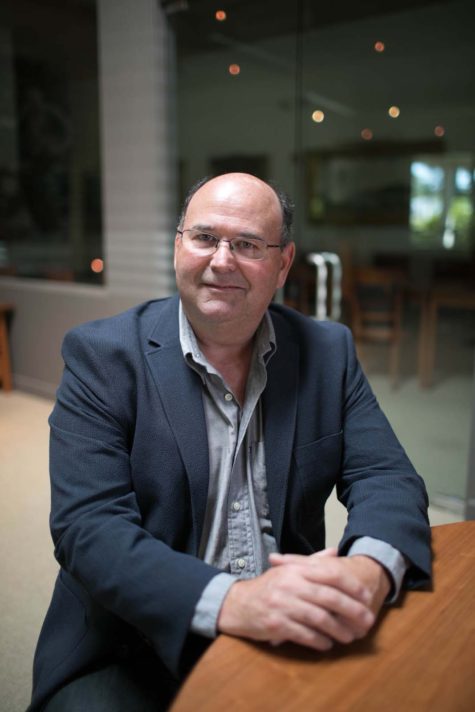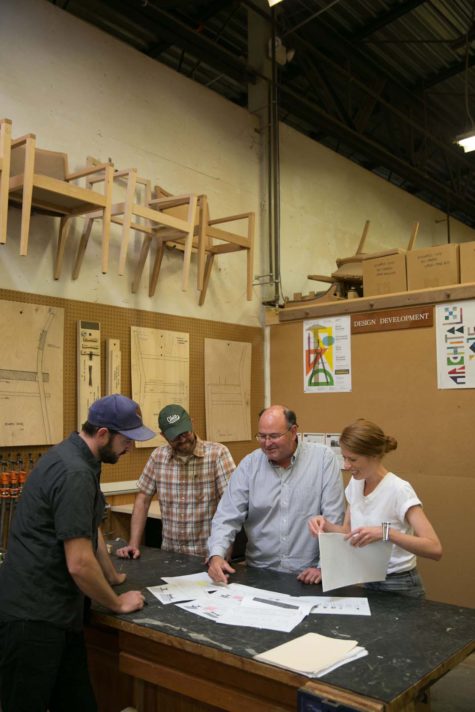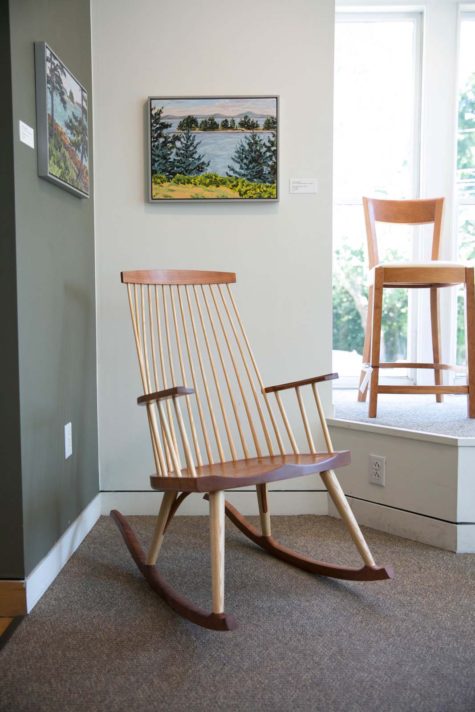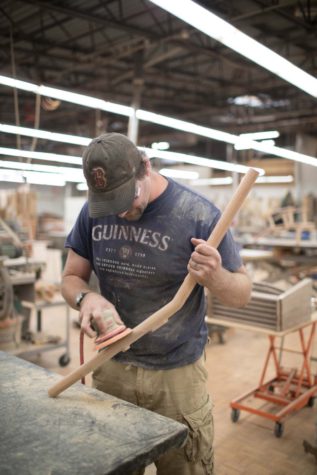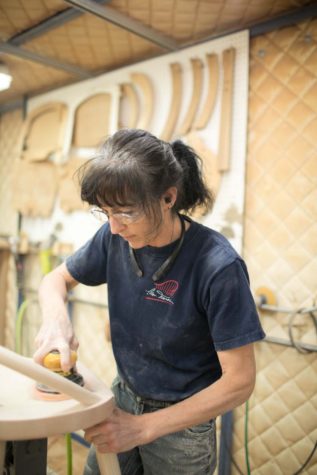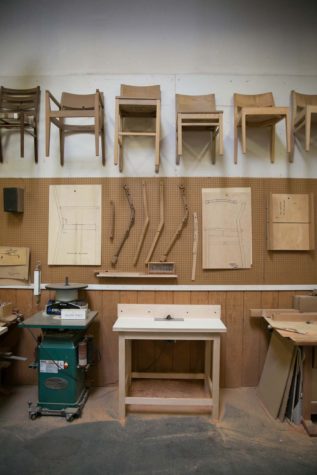Making the Complex Look Simple
A new generation takes charge at Thos. Moser.
By: Philip Conkling
Photography: Matt Cosby
Many businesses like to say, “We are all like family here.” But what if your business actually is a family enterprise, root and branch, like Thos. Moser Cabinetmakers, Maine’s most respected and successful furniture maker? And what if the 82-year- old-founder, Tom, and his wife, Mary, and three of their four sons, and one daughter- in-law, are all still intimately involved in the business more than 40 years after it started? And how does a family business transition from a charismatic founder-led enterprise to new management when the time comes?
The Mosers’ answer is: slowly, carefully, and not without difficulty.
There is nothing about Moser—the man, the company, or the family—that fits a predictable story line. Aaron Moser, 52, Tom’s third son, who was recently appointed the company’s president and CEO, started out in the food business after graduating from a rigorous program at the Culinary Institute of America. He began his professional life as a chef in New Orleans before migrating to Dallas to work as a chef and food service manager. But homesick for Maine, he “came home, got married, had two children, and built a bunch of houses—including a boat barn and studio for my father on Dingley Island.” Recruited into the family business three decades ago, Moser built the contract side of the business, focused on building furniture for colleges and universities, in addition to working for his father in various other capacities. “It’s not about taking charge,” he says of his new role. “It’s been more of a process.”
Reflecting on the family’s personal and business philosophy, Moser says it was always in his father’s nature to blaze his own path. “What other college professor shows up for work with Band-Aids all over his fingers after a weekend tearing down barns?” His father left a tenured position at Bates College—along with its promise of free tuition for his four sons—to start a furniture company in 1972. “Who else would do that?” Aaron asks. Then he adds, “What other furniture company sells the furniture it makes through its own network of national showrooms? And what other furniture maker produces this level of quality at this scale of quantity?” When his father was writing the book ultimately titled , one of its early working titles was With the Grain. Aaron thought it would have been more aptly titled Against the Grain.
To understand how the company and its 130 employees create their signature furniture pieces, I go with Moser on a tour of the company’s 90,000-square-foot plant in Auburn. A one-time forester myself, I appreciate the carefully curated supply of elegant hardwoods at the southern end of the company’s long, low building. We walk past stacks and stacks of beautifully colored lumber—purplish-tinted walnut, rose-hued cherry, pale white ash, along with stockpiles of rock maple and white oak.
“We have some of the finest sourcing in the furniture business,” says Moser. The company has always maintained excellent relationships with premium lumber mills. “The quality of our wood has become part of our brand,” he says, adding, “You end up with what you start with.” He points to a couple of pieces of black walnut sourced from a mill in Missouri. “No two boards are the same, just as no two trees are the same.” The company’s woodworkers, he tells me, would never use a cherry plank from Kentucky next to one from, say, Pennsylvania, because black cherry wood changes color over time, depending on the soil type and climate where it grew.
The Moser plant is laid out to create a large number of artisanal spaces for one or two woodworkers to shape and assemble chairs, bookcases, tables, benches, and other furniture. Moser’s woodworkers—almost half are women—are not assembly-line workers. “They all have a lot of autonomy and accountability,” he tells me. All Moser craftspeople sign and date their own pieces—and repair them if necessary, in keeping with the furniture’s lifetime warranty. One of the goals of the company is that a piece of furniture, intricately assembled from hardwood planks from a single tree, will last as long as it takes that tree’s replacement to grow to maturity—at least a half-century for most of the wood that surrounds us.
Even though Thos. Moser’s furniture design department has access to high-tech computer visualization tools and the company employs skilled programmers to set up its CNC machines (computerized cutting machines), Moser insists that “we use tech; we don’t let tech drive the design.” A CNC machine setup can “take long hours,” says Aaron, “but the point is that we can then make pieces of furniture one at a time, enabling us to focus on fit and finish.” He calls the balance between the company’s handwork and technology “high-tech, high touch.”
At one workstation, Moser introduces me to Brenda Swett, who is working on attaching legs to a chair, but Moser seems equally proud that a number of years back she was Maine’s state champion bass fisherwoman. Nearby, Moser waves to Ramsey Uter, a wood carver originally from Jamaica. Tom Moser and Uter recently collaborated on crafting a small wooden carousel horse, which is currently on display at the Maine State Museum, part of an exhibit celebrating the 45-year history of Moser and the company’s contributions to Maine art, design, and entrepreneurship.
Simple Shaker designs were an early influence on furniture designed by Tom Moser, but today the company’s design inspirations come from all over the world. Perhaps no other design has done as much to imprint Thos. Moser’s furniture in the minds of the company’s clients, customers, and admirers as a line of Windsor-inspired chair designs, whose signature effect is created by a double-curved, continuous- arm back. Aaron Moser shows me a jig, which was designed in 1972 and has been used ever since. The jig is used to bend the sections of glued laminates into their elegant shapes, beginning at a slightly upturned arm rest, then swooping up, around, and down to the opposite arm rest like the curves on a roller coaster. “This is not something a machine could do for us,” Moser says.
We end our circuit through the plant at the section where the various oils and finishes are applied to the company’s furniture. Moser mentions three large orders that were recently shipped out—one for Yale University’s new residential college, another to the University of Georgia, and a third to the Lawrenceville School, a New Jersey boarding school. As we walk around a finished cherry desk and chair awaiting shipment, I am impressed with the visual depth of the light that penetrates into the wood. The color of the wood seems to change from different angles as the interplay of light and shadow creates arresting effects, brought out by the final process of applying oil. “If we’ve done everything right,” Moser says, “this is an enchanting process.”
Through an unimposing door next to the shipping department, Moser leads me back into a quiet, well-appointed conference room, adorned with framed nautical art of clouded seascapes and breaking waves. I mention the long and winding road that has led him to his new leadership position at one of Maine’s most admired family companies. “Not a winding road,” Moser says philosophically. “More like hills and valleys.”
“The founders—and the whole family—we are all going through a transition,” he says. “It’s tough work to let go.” He adds, “It’s intimidating to work under Tom Moser. He’s a brilliant visionary, a strong leader, and he’s also an incredible orator.” The younger Moser says it wasn’t his aspiration to become the company’s leader. “This came to me,” he says with sincere humility. He recalls a magazine interview from 1996 in which his father first mentioned the need to plan for a leadership transition. “I don’t know how long a transition is supposed to last,” he says, “but it would be harder for an outsider to do this.”
Aaron Moser has assumed the leadership role of a successful company that in its 45th year is at “a halfway point” in its history, with a third-generation Moser now working at the company. “Everything we do here has some level of emotion. Our employees are deeply committed to this family, to the business, and to each other,” he says. The company, he adds, is also deeply committed to Maine. Like another figure in the Moser family, Aaron becomes a bit of an orator as he emphasizes that “our company wouldn’t and couldn’t exist anywhere else but Maine.” He cites the surrounding rural culture and strong family roots that have shaped those who have worked for the company for decades. And when he mentions his belief that Mainers’ innate sense of connection to the natural world is infused in the company’s products, I am reminded of something he said to me standing next to the jig designed in 1972. “We are not trying to be fanciful or clever. We are trying to be truthful. We are trying to be simple.”
’Tis the gift to be simple, as the Shakers, who inspired some of Moser’s earliest designs, once put to song.
This article was originally published by maine. magazine. Maine Media Collective © 2017

